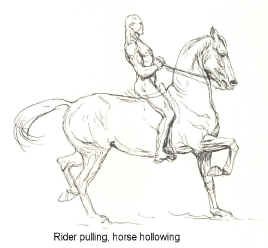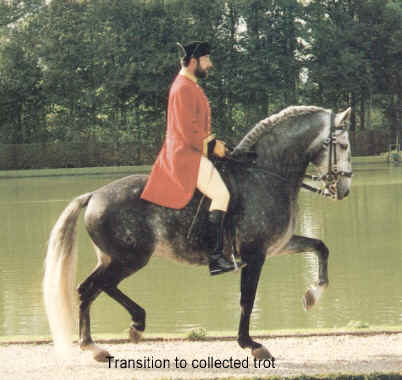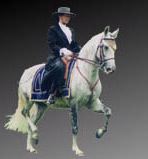 |
classicaldressagescotland.com |
| Lesson 11: Transitions |
| New web address: www.classicaldressagescotland.com |  |
| About this site | About us | Personal Tuition | Video analysis | Lesson menu | Portugal and Lusitanos |
| Home Schooling Classical dressage Modern dressage Horse trials Show jumping Glossary Links |
What is a Transition?Well, to put the movement in its simplest terms, a transition is changing the way the horse moves across the ground by altering the speed or gait from one to another. As with most "simple terms", especially with the training of horses, there is no such thing as a "simple term". Transitions are far from being a simple start, stop or go faster. Transitions, if ridden correctly, are a key ingredient for increasing:
Back to BasicsThere you are, driving down a pleasant country road at about 50 mph. All of a sudden a tractor pulls out from a side lane right in front of you. You will, in a blink of an eye slam your foot down on the brake pedal and skid to a halt. No harm done, everybody is happy and because of your attentive driving, you have avoided a very nasty accident.As you drive away from the scene of the near accident, analyse what happened to you and the car when you slammed your brakes on. Of course, the nose of the car dipped down, the car became nose heavy. In riding terms, on its forehand, and the occupants of the car were thrown forward. This is not what you want when you ask you horse to slow down or even stop. You are trying to get your horse to be light in the front, not heavier, and you the rider must stay in balance, not thrown forward up the horse's neck. 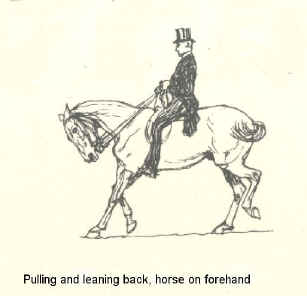
The message here is that unlike a car, a horse does not have a mechanical brake. Unfortunately, many riders cannot make that distinction and use the reins as the equivalent of the brake pedal, and just haul back and expect the horse to respond the same as a car. OK I realize that the scenario I have just described was an emergency situation. Luckily dressage is all about preparation and not sudden emergency situations, and it's fairly unusual for a tractor to pull out in front of a rider in a dressage arena or manege. Unless of course you are competing in Scotland and then anything can happen. I remember competing in Edinburgh some years ago, and as I was turning the corner just past the C marker, to ride the medium trot from M to F, the row of ornamental trees that lined the arena were blown down onto the track. Luckily the horse was fairly laid back and we completed a very decent show jumping course with no faults down the long side. But that's another story. In the Beginning, There Was the VoiceGood transitions are taught at a very early stage in the horse's career. In fact the first transition should be taught in the stable. The aim of the lesson is to teach your horse to stop or slow down without having to use a collar or bridle. From a head collar you should be able to stop your young horse with a slight pressure across his nose, backed up with the voice. Slowly over a period of time, your horse will respond to the voice only and the restraining feel of the head collar will become redundant.Take this lesson to the manege and on the lunge. Start by having a helper lead the young horse. Use your voice with a downward intonation and have your helper put a little pressure on the horse's nose with the cavesson. Your young horse will soon learn that he has to stop when asked so will not bother to lean against the cavesson. He will just respond to the voice. You have taught your horse that he does not need pressure on his nose or his mouth to slow down or stop. Then Came the SeatJust as an experiment, take your whip into your left hand and reverse it so that it is poking upwards into the air. Leave about six inches of handle sticking out below your hand. Now take you right hand flat up against the handle of the whip. Now try and move your hand backwards and forwards. It's difficult, isn't it? The stiffness of the handle stops your hand from moving freely.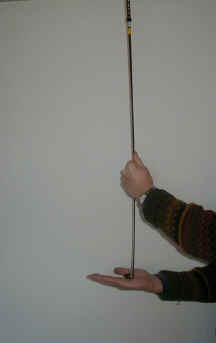
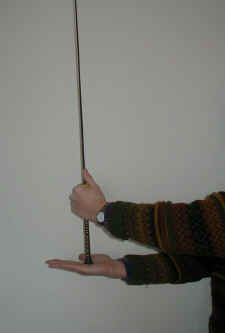
Take the same whip and point it the other way up. That's to say the handle is the highest point, the lash the lowest. Hold the whip in the left hand about five or six inches above the lash. Once again take your right hand, flat and bring it up against the bottom of the whip. Now move your hand backwards and forwards. Because the whip is supple at this end, your hand is easier to move. That's the basic theory, and what you are trying to do with you seat and back. Keep it supple when you want the horse to go forward. Sit against the movement, being momentarily stiff when you want the horse to slow down or transition. That of course is putting the aids for a transition into its simplest form but the theory is sound. The AidsLet's try and put the theory into practice and use the seat, back and legs to practice good and effective transitions.Let's use a transition from trot to walk as a starting point. Make a positive decision as to where you want the transition to be. That's important. If you don't use accuracy now, how will you know what you are doing is correct and positive, and how will your horse cope in competition when accuracy is everything. Initially your young horse will not be accurate, it takes time to learn, but you must still keep trying. 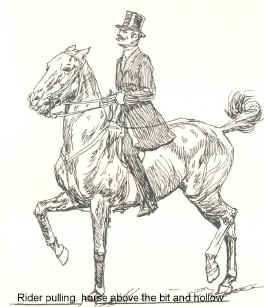
As you are approaching the marker, just stop the reins moving in harmony with his movements. Close your knees and thighs more firmly against the saddle, and by tightening the stomach muscles try to sit against the movement. That will dampen down the horse's movement through his back and make it difficult for him to move freely. Do not grind down onto the horse's back. Try to think of you shifting your point of balance away from your stomach and up into your chest. The seat must lighten to accept and horses rounded back and restricting enough to stop the forward momentum. As soon as your horse goes down into walk, back off. Soften the rein and soften your legs and back. Stay in balance and stay in posture. You are now back into harmony with him and he can walk freely forward. Don't forget to reward the horse. Easier Said Than DoneIt's easy for someone like me to spout the theory and expect wonderful things to happen straight away. Not true. Bearing in mind all the movements in dressage, the transitions, especially the downward transition is the movement that your little darling will find the most easy to wriggle out of. What do you do if your horse now uses one of the normal evasions and earns you low marks in the arena and a headache in the manege? The most common problem is that the horse will hollow his back and poke his nose out as soon as you even think "downward transition". This often happens with a horse that's a bit older and has been ridden with hands only. This also happens I might add, with a horse whose rider is trying to ride the classical way but just being too strong with the back. Anyway, how are you going to solve this problem? The first step with this problem is to analyse your position, balance and the strength of your back. It's fairly easy to apply the back aid; it's a little more difficult to back off and let your body go into neutral just at the right moment. Are you grinding down on the horse's back during transition and are you dampening down the horse's movement too long. As soon as you feel the horse respond, soften your back, go into neutral. Feeling and timing is everything. If you feel that the horse is just being disobedient or avoiding the work or has got into a bad habit, it really is just a question of not letting your horse poke his nose. You must block. Not pull back, that would be very wrong. Just block. As soon as your horse carries his own head and arches his neck in self-carriage, soften the rein. Once again, timing is everything. If you hold too long, the horse will just lean on your hands and then you're back to square one. If your horse is really heavy and fighting your hands to come above the bit, especially in the trot to walk transition, this is what you do. As you apply your back, seat and leg aids, just move the bit in his mouth so that he does not have a solid object to lean on. A little non-rhythmic wiggle-waggle with your hands, as strong as it takes to get a response. I am not saying here to saw the mouth; that would be a total no-no, and you must never do that. I cannot emphasize that enough. You just want to keep the bit "juicy" in the horse's mouth. Once again, as soon as the horse backs off and carries himself into a soft jaw, you back off, soften and keep the rein still and soft. This poking the nose and hollowing the back sometimes happens in the upward transitions. I have found this usually happens with horses that have been used as for show-jumping or racing, and the leg aid to go forward is invariably followed by a jump or a prolonged gallop. The horse is just going into self-preservation mode and wants to see where he is going. Use exactly the same techniques as the downward transition except do not use the back aid to dampen down your horse movement. Sit, but keep your body in neutral / harmony. Go with him. Follow the movement. Once again, as soon as your horse goes into self-carriage with a soft jaw, relax your hands and follow the movement. Reward him with inside hand. Will Not Stand SquareThe transition from walk, trot or canter to halt. This is a real easy problem to solve. Make a decision to never let your horse stop without standing four square. At the end of every training session from here on in, make your horse stand square by using your legs. A little short walk forwards if the halt transition has been really bad. As soon as your horse stands square, pat him and dismount. Getting off your horse is the ultimate reward and he will soon learn that when he stands correctly, there is a chance you might get off. It works, try it.Will Not Engage His Hindquarters During Downward TransitionsThis is also a common fault. The reason it happens is that your horse is hollowing his back and leaving his hindquarters behind him. Use the hands as described above in exactly the same way, but use a little more leg during the transition. Remember, you are trying to close you horse up from behind, so use your leg aid, and I mean a listening leg, backed-up with the whip if he is being lazy, even if the transition is from canter to trot. Make time to pat your horse if the transition was successful or at least showing an improvement.A Few Hints and Tricks From Nuno Oliveira
Summary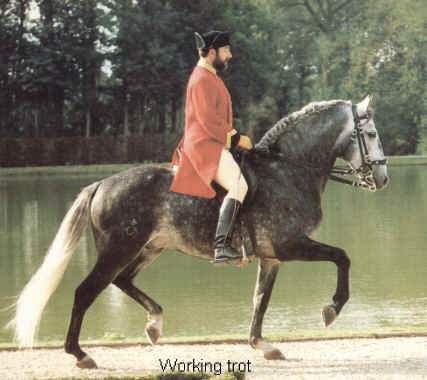
I shall come back to transitions in later lessons. I have not covered the transition from one pace within the gait to another, for example, medium or extended trot to collected trot, collected canter to extended cater or collected walk to extended walk, etc. If however you are having problems with these transitions or would like to know more now, send me an email.
As usual to finish this lesson I will quote from the Master Nuno Oliveira
Enjoy this lesson and don't forget I am here to help. Don't struggle on your own.
|
